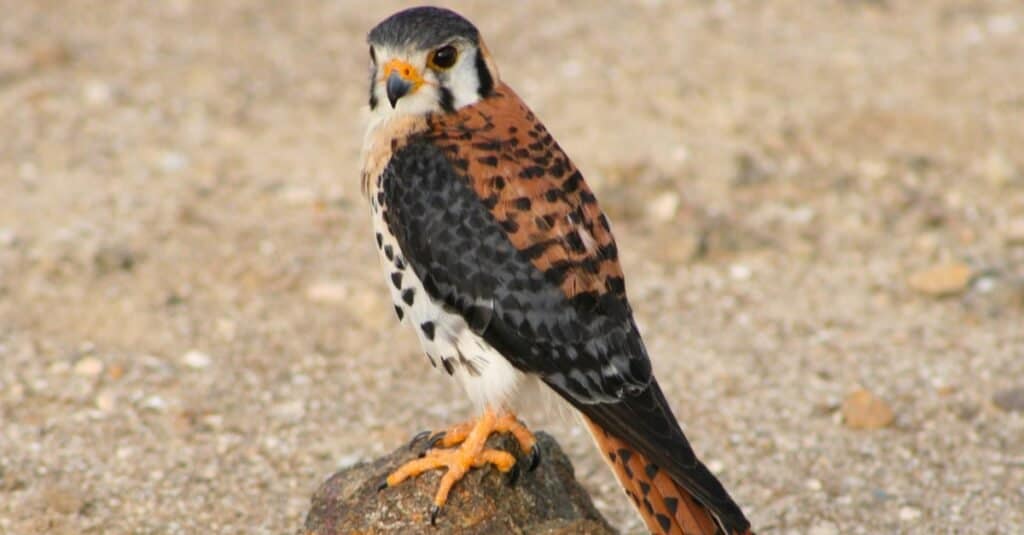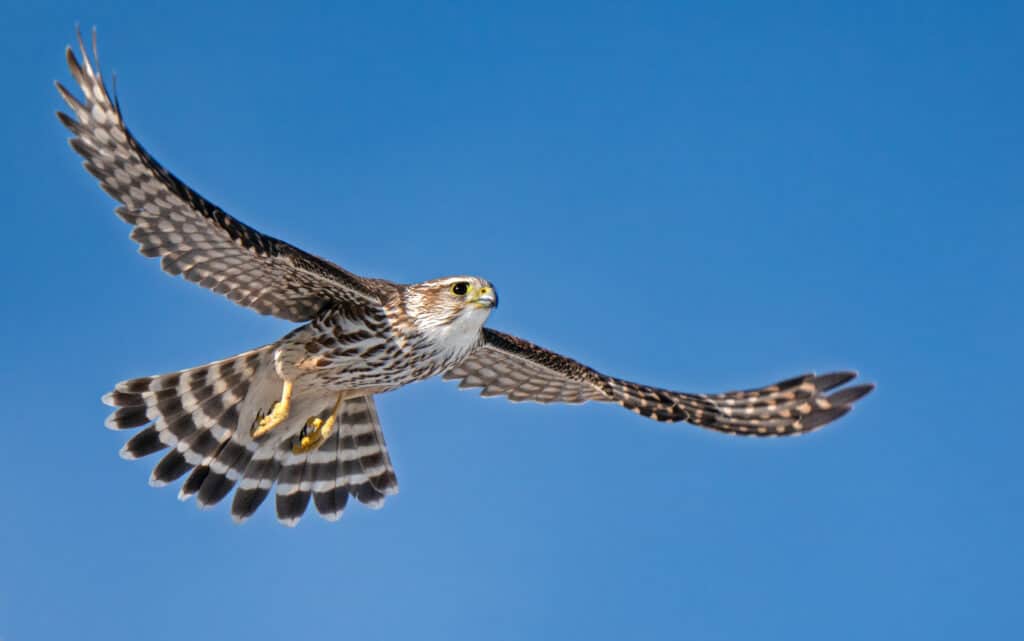Scientists used to believe that falcons were types of hawks, but it turns out that hawks and falcons aren’t closely related. Falcons belong to the Falconidae family, and the Falco genus. Alternatively, hawks are members of the Accipitridae family. Falco is a Latin word for sickle and refers to the shape of the bird’s deadly claws.
Falcons have streamlined bodies, long, pointed wings, and tails that taper. They are also some of the fastest flyers in the world and kill their prey with their beaks, thanks to an extension that is much like a tooth inside the beak. Hawks and other birds of prey use their talons. Here are three falcons found in Georgia’s skies.
1. Peregrine Falcon

The
peregrine falcon
is considered the fastest creature on the planet.
©Harry Collins Photography/Shutterstock.com
This falcon, Falco peregrinus, is not just found in Georgia, but just about everywhere on earth save rainforests, Antarctica, and the coldest areas of the Arctic. It prefers to live in open places such as meadows and grasslands, and you’re also likely to see them around the coasts or at lake shores. They have famously begun to populate cities as the skyscrapers resemble the rocky cliffs and crevices that are the falcon’s preferred places for building nests and raising chicks. On top of that, cities are full of pigeons and other prey.
Peregrine falcons are also famous for being the fastest birds in the world. During a dive, this bird can achieve speeds of over 200 miles per hour.
What It Looks Like
The peregrine falcon is between 13 and 23 inches long and has a wingspan of between 29 and 47 inches. Their wings are slaty or bluish gray with black tips, their backs have darker bars, and their bellies are white or rusty with beautiful dark brown or black barring. You’ll also notice bars and a white tip on the tail. Their cheeks bear a black stripe, which scientists believe cuts down on sun glare, like eye black on a football player. The top of the head is also black, and the neck and throat are white. The falcon’s feet are yellow, but its claws are black, as is its beak. The bird has a large, dark eye. They weigh an average of two pounds, and though they have similar plumage, females are larger than males. This is the usual thing with birds of prey.
Reproduction
These birds are monogamous, but some scientists believe that they are more faithful to a nesting site, which is used over several seasons, than they are to each other. Part of the falcon’s courtship ritual involves sensational aerial acrobatics that includes rolls, spirals, and breathtaking dives. Females even fly upside down to catch prey the male has caught and passes to them. In Georgia, the only natural peregrine falcon nesting site is in Tallulah Gorge State Park.
The diet of the peregrine falcon is mostly smaller birds, especially types of doves. Other birds include grouse and songbirds. Now and then the falcons eat smaller mammals and reptiles, including bats, rats, and squirrels. They usually swoop down on prey from a high perch, but sometimes they’ll go to ground to find a meal.
After the male and female bond, the female prepares a nest. She simply scrapes a shallow depression out of a ledge, cliff, or crevice or takes over an already existing nest. Then, she lays between two and six eggs. She’ll lay one egg every 48 hours or so. Both the male and female incubate the eggs, which hatch in a little over a month. The chicks, which are fed and brooded by both parents, fledge after 35 to 42 days. The parents teach their chicks the finer points of flying by catching prey, dropping it in midair and letting the newly fledged chicks go after it.
Peregrine falcons are territorial during the breeding season and defend their nest against all trespassers, even if they are much bigger than the birds. A pair of peregrines could have several nests in their territory.
Lifespan and Conservation Status
Though peregrine chicks have a high mortality rate, falcons who do live past their first year can live to be between 16 and 20 years, though the famous Pale Male, a peregrine falcon that lived in New York City, was thought to be in his 30s when he died. Females are ready to mate when they’re between one and five years old, and males are ready when they’re between two and eight years old. The conservation status of the peregrine falcon is least concern after years of population decline due to pesticide contamination.
2. American Kestrel

This small, pretty falcon is also found in Georgia.
©Megan M. Weber/Shutterstock.com
This attractive little falcon, Falco sparverius is the most common falcon in North America and the smallest. It is a year-round resident of Georgia and 34 other states. It is only between 8.7 to 12.2 inches long with a 20- to 24-inch-long wingspan. The bird weighs between 2.82 and 5.81 ounces. Like the peregrine falcon, the female is larger than the male. The wings of the males are bluish gray with black spots, while those of the female are rufous with brown bars. The males also have a white underpart with black bars, though the bird’s belly is white with black spots. The faces of both sexes bear double black slashes, and there are black spots on the back of the neck.
Where To Find It
The American kestrel can thrive in a variety of habitats, including cities, mountains, open areas such as meadows, farms, and deserts. They need open areas and a tall perch where they can easily spot prey and easily catch it. Prey includes insects and small mammals such as mice and shrews, smaller birds, snails, squirrels, frogs, and snakes. The type of prey depends on the season. Insects are taken in the summer, and vertebrates are eaten in the winter.
Reproduction
Like peregrine falcons, American kestrels are monogamous, and their courtship involves aerial performances. Pairs also come back to the same nest year after year. Nests are usually built on building ledges, cliffs and crevices, or even fences and utility poles. They’ll also use woodpecker cavities or empty nests. In Georgia, the breeding season is in early spring. The female lays between three and seven eggs, and they hatch after about 30 days. She incubates the eggs, and the male feeds her while she does. As the chicks grow, the father becomes more and more scarce, though the mother stays with them. The chicks fledge about 30 days after hatching, and three weeks later they’re independent.
American kestrels usually live about 11 years in the wild. Their conservation status is least concern.
3. Merlin

The merlin is another falcon found in Georgia’s skies.
©Rob Palmer Photography/Shutterstock.com
The merlin is more robust than the American kestrel. Falco columbarius is also known as the pigeon hawk because it often preys on smaller birds. They’re not only pigeons and doves but quail, finches and sparrows. They’ll also take small reptiles, insects and small mammals. There are nine subspecies of this falcon, and the subspecies F.c. columbarius can be found in Georgia. It flourishes in open areas such as marshes, deserts, grasslands and by the sea. This type of habitat allows the bird to spot prey and swoop down on it.
What Merlins Look Like
Like American kestrels, merlin males and females have somewhat different plumage. The bird is between 9.4 and 13 inches long and has a 20-to-29-inch wingspan. The males have a purple, dark brown or slate blue dorsal area with a streak of black from the top of the head and down the shoulders to the back. He weighs about 5.8 ounces, has dark brown or black bars on his tail, and the tip of the tail is white. The ventral parts of the male bird are cream or buff with streaks of dark brown or black. Only the throat is pure white. The buff-colored head has dark streaks, and there’s a white line above the eye and a white forehead. He has a blue beak, black claws, dark brown eyes, and yellow feet.
Females are a little larger and weigh about 8.1 ounces. The female’s dorsal area is dark brown, and she has light brown streaks on her neck. Her tail has yellow bands and is edged in white. In F.c. columbarius the male’s feet and cere, the waxy covering at the top of the upper beak, turn red as the bird gets older.
Reproduction
As with the peregrine, nests are usually just scrapes, though merlin pairs can use abandoned nests. During the mating season, merlins grow aggressively territorial and see off even large birds of prey. The breeding season is in early to mid-spring.
The female lays between four and six eggs, one every 48 hours. Both parents incubate the eggs though the female does most of the work. The male hunts but grows distant from the nest over time. Soon, he’ll start to simply leave prey nearby for the female to pick up. The eggs hatch after 25 to 32 days. The chicks fledge after 18 days, and they’re ready to fly about a month after they hatch. Yet, they stay near their parents and learn to hunt.
Merlins live around 12 years in the wild, and their conservation status is least concern.
The photo featured at the top of this post is © Rob Palmer Photography/Shutterstock.com
Thank you for reading! Have some feedback for us? Contact the AZ Animals editorial team.







